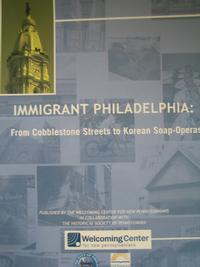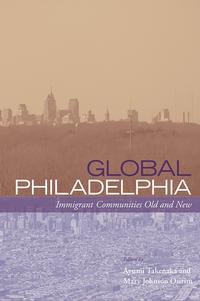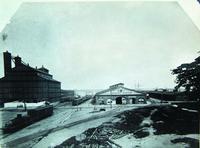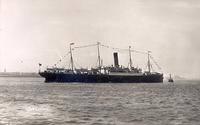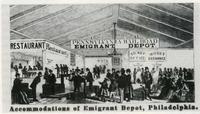Washington Avenue Immigration Station: 1873-1915
In 1870, Philadelphia was no longer the nation’s largest city, but rather the "Workshop of the World" with an endless need for skilled and unskilled workers. This, along with established and welcoming communities of previous immigrants, attracted many of the millions fleeing poverty and political unrest in Europe. Most of these immigrants landed first in New York or Boston, ports that offered shorter voyages and fast ships powered by steam rather than sail.
In 1872, over 400,000 immigrants arrived in the US, and records show only 154 officially entered through Philadelphia. This was a sad state of affairs for our once thriving port, but one man saw it as an opportunity.
Clement Griscom was born a Quaker, a direct descendent of Andrew Griscom, who came to the New World with William Penn in 1682. He grew up in a well-to-do family, was educated in Quaker schools, and graduated from Central High. But instead of going to college with his classmates, Griscom took a job as a clerk with a shipping firm. By age 22, he was a partner.
Griscom was fascinated by international shipping and longed to see the U.S. reclaim the dominance it had lost as steamships took over the business. He found a willing partner in the Pennsylvania Railroad. Since its inception in 1846, the railroad had expanded its reach by building and buying up local train lines throughout the east and midwest until it had direct access from Philadelphia, west to Chicago and St. Louis, and north to all the Great Lakes. It was the major transporter of coal, oil and agricultural products to the major cities of the east coast as well as European ports. By 1870, the PRR was looking to expand into shipping. Griscom and PRR first formed The American Line with four steamships built in the U.S. then expanded by creating the Red Star Line using ships built in Antwerp with subsidies from the Belgian government. Part of PRR’s contribution to the venture was to provide the docks in Philadelphia. In addition to a number of warehouse docks from Girard down to Dock Street, the Pennsylvania Railroad built the Washington Avenue Immigration Station on Pier 53 in 1873.
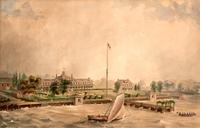 The Washington Avenue Immigration Station was much smaller than Ellis Island, in part because it did not need a medical facility or quarantine hospital. Medical screening was done at the Lazaretto, down river, before ships reached Philadelphia. The station had two levels. Passengers entered on the upper level where they went through the customs and immigration process. Single women were often denied entry, since it was thought that they would be unable to support themselves and forced to turn to prostitution. The immigration station provided a place where couples could be married on the spot, enabling more women to enter the country legally. The lower level offered a currency exchange, dressing rooms, and a ticket office. Immigrants could walk across the street and board a PRR train to the coal mines, factories, and farms of the Midwest or Great Lakes region. Many headed for St. Louis and continued from there to the California gold fields. The Red Star Line in Antwerp sold tickets that included both a berth on a ship and a train ticket to any destination on the Pennsylvania Railroad line.
The Washington Avenue Immigration Station was much smaller than Ellis Island, in part because it did not need a medical facility or quarantine hospital. Medical screening was done at the Lazaretto, down river, before ships reached Philadelphia. The station had two levels. Passengers entered on the upper level where they went through the customs and immigration process. Single women were often denied entry, since it was thought that they would be unable to support themselves and forced to turn to prostitution. The immigration station provided a place where couples could be married on the spot, enabling more women to enter the country legally. The lower level offered a currency exchange, dressing rooms, and a ticket office. Immigrants could walk across the street and board a PRR train to the coal mines, factories, and farms of the Midwest or Great Lakes region. Many headed for St. Louis and continued from there to the California gold fields. The Red Star Line in Antwerp sold tickets that included both a berth on a ship and a train ticket to any destination on the Pennsylvania Railroad line.
Griscom’s gamble paid off and by 1910, when Philadelphia became the country’s third largest immigration port. Many immigrants chose to stay in Philadelphia. They could walk from the Immigration Station to the Irish and Italian neighborhoods of South Philadelphia or the Jewish neighborhood near South Street. In fact, Philadelphia’s Jewish population became the second largest in the nation. The Washington Street pier was torn down in 1915 in anticipation of rebuilding by the federal government, but the drastic reduction in immigrants during WWI and the strict immigration laws of the 1920's eliminated its need.
In 2014, Pier 53 reopened as a waterfront eco-park. It features Land Buoy, a sculpture featuring a spiral staircase with a crow’s nest. Artist Jody Pinto hopes visitors will climb her stairway and experience what it must have been like for immigrants to see their destination for the first time. If you visit the park you may run into Susan McAninley, a Pennsport resident who has spent several years recording stories of the immigrants who passed through the center. McAninley searches immigration and genealogy files and records the stories to build portraits of the real people who passed through the station. She then shares these with local history groups stating, "The desire to make a better life was the same a hundred years ago."
Read more...
Have a question for Free Library staff? Please submit it to our Ask a Librarian page and receive a response within two business days.

